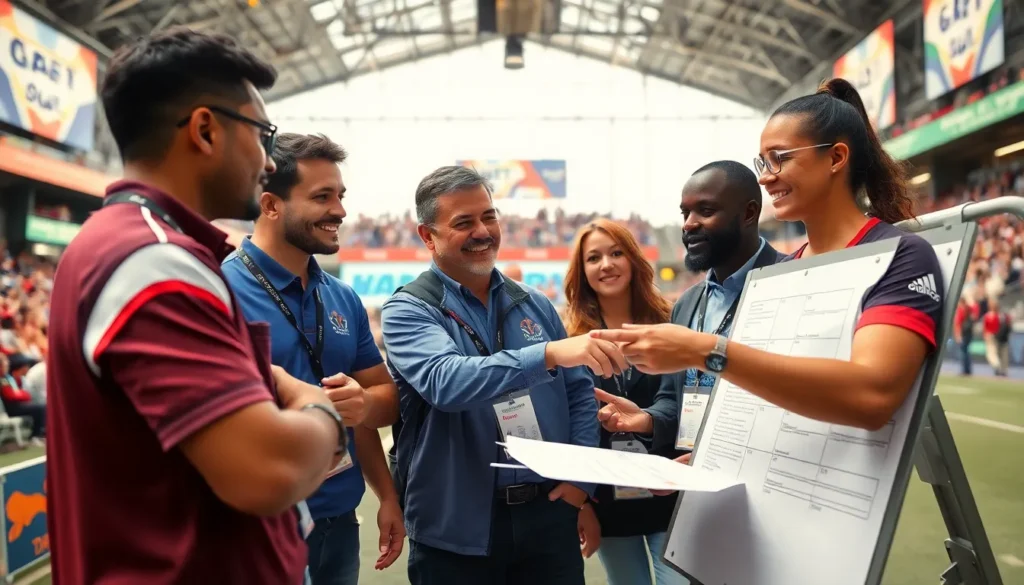When it comes to sports, timing is everything. Imagine a world where you miss the thrill of the Super Bowl because you thought it was just a regular Sunday. Oops! The sports seasons calendar is your trusty guide to avoid such epic fails. Whether it’s the excitement of football in the fall or the nail-biting drama of basketball in spring, knowing when each season kicks off can make or break your game day plans.
Sports Seasons Calendar
Sports seasons function as a timeline for various athletic events throughout the year. Different sports commence and conclude at specific times, ensuring fans have opportunities to engage with their favorite games.
Football seasons typically start in early September and run through early February, culminating in the Super Bowl. Basketball, on the other hand, launches in mid-October and wraps up with the NBA Finals in June.
Many fans also follow baseball, where the season begins in late March or early April and extends into October, featuring the World Series. Soccer leagues operate on a different schedule; for example, Major League Soccer kicks off in late February or early March and runs until October.
Track and field competes mainly in the spring and summer months, with championships often scheduled for late June or early July. The NHL hockey season starts in early October and lasts until April, followed by the playoffs.
Understanding the sports seasons calendar offers fans a strategic advantage to plan their viewing schedules, purchase tickets, and engage with their teams. With clear start and end dates, sports enthusiasts can easily follow various leagues and events, ultimately enhancing their overall experience.
Major Sports Seasons

Sports seasons offer a structured calendar for fans to enjoy their favorite games. Knowing when each sport takes place enhances the viewing experience.
Football Season
Football season typically starts in early September. The regular season spans 17 weeks, concluding with the Super Bowl in February. Fans eagerly follow major events like kickoff weekend and Thanksgiving Day games. Notably, the NFL playoffs follow the regular season, culminating in the championship. Spectators celebrate every touchdown, making this time of year exhilarating for players and fans alike.
Basketball Season
Basketball season kicks off in mid-October. The NBA regular season lasts until April, featuring 82 games for each team. Key events include the All-Star Weekend, held in February, showcasing the league’s top talents. Following the regular season, the playoffs begin, leading to the NBA Finals in June. Each game captivates fans with high-intensity action, creating a thrilling atmosphere.
Baseball Season
Baseball season usually starts in late March or early April. Teams prepare for a grueling 162-game season that stretches into October. Major events, such as Opening Day, generate excitement across stadiums. The playoffs begin shortly after the regular season ends, highlighted by the World Series. Each game provides fans with iconic moments and a leisurely pace that’s distinct to this summer sport.
Hockey Season
Hockey season generally commences in early October. The NHL regular season runs until April, featuring 82 games per team. Playoff excitement follows the regular season, culminating in the Stanley Cup Finals. Fans anticipate key dates like the Winter Classic and trade deadline day, enhancing the season’s allure. Each match showcases speed and skill, drawing dedicated supporters throughout its duration.
Regional Variations in Sports Seasons
Sports seasons vary greatly by region, reflecting local culture and climate. Fans benefit from understanding these differences.
North America
In North America, sports seasons are distinctly marked. Football season kicks off in early September and runs through February, culminating in the Super Bowl. Basketball follows, with its season starting mid-October and ending with the NBA Finals in June. Baseball spans from late March to October, featuring the World Series. The NHL captures the winter months, starting in October and concluding with playoffs in April. These timing patterns help fans coordinate their sport-viewing schedules and activities efficiently.
Europe
Europe’s sports calendar presents its own unique rhythm. Football, known as soccer in North America, dominates the scene, typically spanning from August to May, culminating in league finals and international tournaments. Cricket, particularly popular in the UK and other nations, often runs from late spring to early autumn, concluding with major tournaments in September. Rugby seasons also vary by country, with club matches held from late summer through spring, often overlapping with major international events. Understanding these schedules allows fans to engage more deeply with their favorite sports.
Asia
In Asia, sports seasons feature diverse timings based on regional sports. Cricket, a major sport in India and Pakistan, often spans from October to March, highlighting tournaments and series. Basketball sees significant attention, particularly in China, with leagues aligning their seasons roughly from November to April. Football’s popularity maintains a year-round presence, although league seasons may fluctuate, often depending on climatic conditions. These varied timelines reflect the cultural importance of sports across Asia, enhancing the fan engagement experience.
Impact of Sports Seasons on Fans and Communities
Sports seasons significantly influence fans and communities by fostering a sense of belonging and excitement. Fans often rally around their favorite teams, creating vibrant community cultures. Connecting through shared experiences, supporters participate in tailgates and watch parties, enhancing local camaraderie.
Local businesses thrive during sports seasons, seeing spikes in sales from merchandise and food. Restaurants and sports bars often create special promotions aligned with game days, driving traffic. Local economies benefit, especially in cities where teams draw large crowds to games.
Engagement in sports seasons encourages civic pride, prompting communities to rally around their teams. This pride manifests in community events, such as parades and celebrations after significant victories. Excitement during playoffs brings neighborhoods together, as supporters unite in shared hope and enthusiasm.
Sporting events also provide opportunities for philanthropy, with teams and organizations frequently hosting charity events. These initiatives promote social awareness and strengthen community bonds. Fans often engage in volunteering or donations, further impacting local welfare.
Youth participation increases during sports seasons, with many looking up to professional athletes as role models. Schools and organizations create programs that encourage physical activity and sportsmanship, fostering well-rounded development among children. This engagement provides an avenue for lifelong bonds formed through teamwork and cooperation.
Ultimately, sports seasons catalyze social interactions, economic development, and community spirit. By bringing fans together, they create an environment where shared passions thrive and connections deepen. Understanding this impact highlights the importance of tracking sports seasons and participating in the communal experience of sports.
Conclusion
Staying in tune with the sports seasons calendar enriches the experience for fans and communities alike. By knowing when each season kicks off and concludes, individuals can fully engage with their favorite sports, from thrilling game days to community celebrations. This awareness not only enhances personal enjoyment but also fosters connections among fans, creating a vibrant culture around each sport. As communities rally together in support of their teams, they build lasting bonds and celebrate shared victories. Embracing the rhythm of sports seasons ultimately transforms the way fans interact with the games they love, making every moment on and off the field more meaningful.



